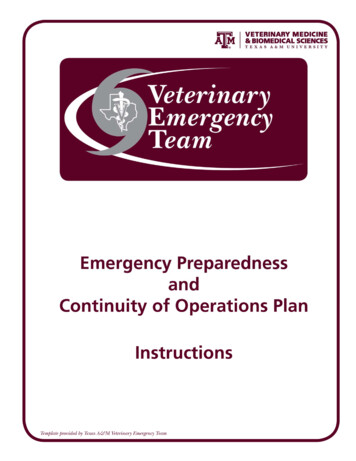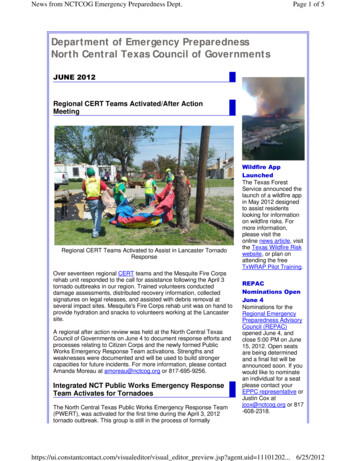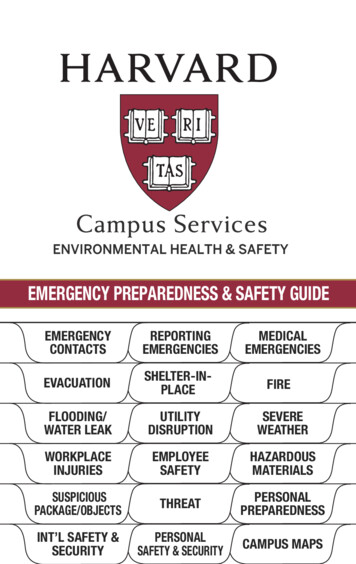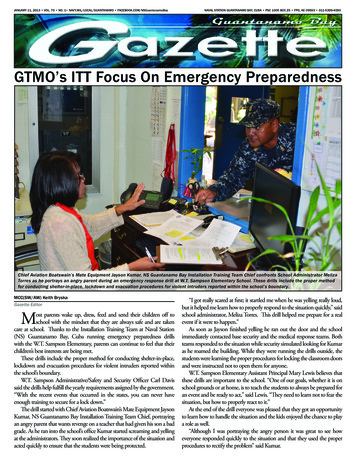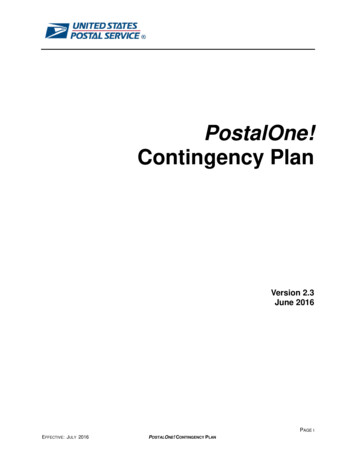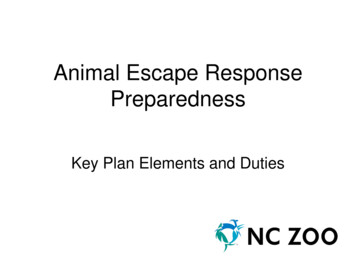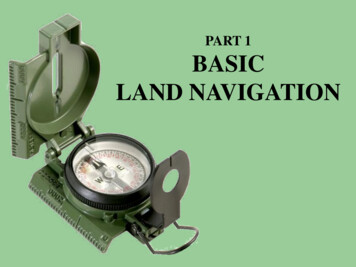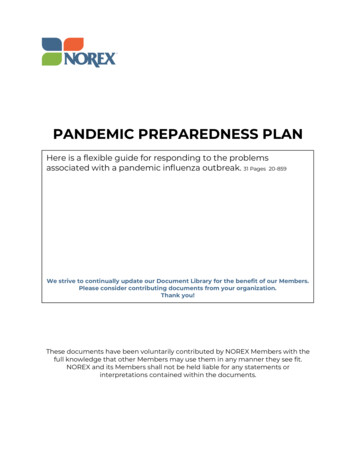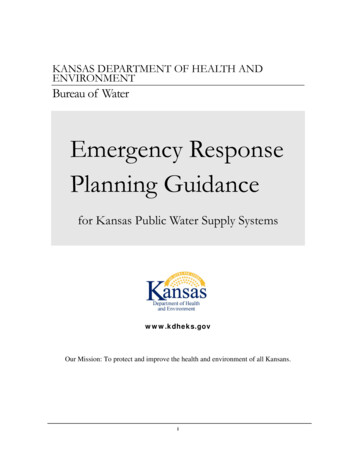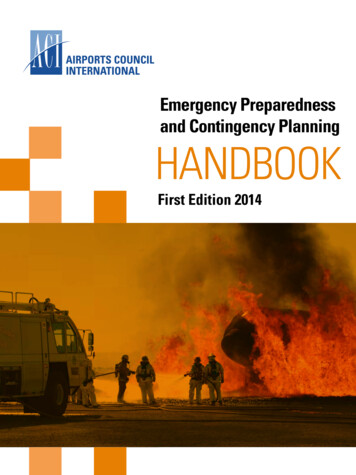
Transcription
Emergency Preparednessand Contingency PlanningHANDBOOKFirst Edition 2014
Airports Council InternationalEMERGENCY PREPAREDNESS ANDCONTINGENCY PLANNING HANDBOOKFirst Edition 2014Authors:ACI World Safety and Technical Standing CommitteeWritten by:Gudjon Atlason (ACI World), Karl Brochu (Aéroports de Montréal),David Gamper (ACI World), Samir Helmy (Egyptian Holding Company forAirports and Air Navigation), Anders Ledin (Swedavia),Changmok Jung (Korea Airports Corporation), Juan Manuel Perez Gilde la Serna (Air Partners Consulting, Spain),P.P. Singh (Delhi International Airport Limited)Reviewed by:ACI World Safety and Technical Standing CommitteePublished by:ACI World, Montréal, Québec, Canada
DISCLAIMERThe information contained in this publication is subject to constant assessment in the light of changingrequirements and regulations. No subscriber or other reader should act on the basis of any suchinformation without referring to applicable laws and regulations and/or without obtaining appropriateprofessional advice. Although every effort has been made to ensure accuracy, Airports CouncilInternational (ACI) shall not be held responsible for loss or damage caused by errors, omissions,misprints or misinterpretation of the contents hereof. Furthermore, ACI expressly disclaims all and anyliability to any person, whether a purchaser of this publication or not, in respect of anything done oromitted, and the consequences of anything done or omitted, by any such person through reliance onthe contents of this publication.No part of the Emergency Preparedness and Contingency Planning Handbook may be reproduced,recast, reformatted or transmitted in any form by any means, electronic or mechanical, includingphotocopying, recording or use of any information storage and retrieval system, without prior writtenpermission from:Director, Safety and Technical AffairsAirports Council InternationalEmergency Preparedness and Contingency Planning HandbookFirst Edition (2014)Copies of this publication are available from:Publications DepartmentAirports Council InternationalP.O. Box 302800 Rue du Square VictoriaMontréal, CanadaEmail: publications@aci.aeroWeb: www.aci.aero/publicationsISBN 978-1-927907-35-1 2014 Airports Council International. All rights reserved.i
FOREWORDThe idea of an ACI guidance handbook on emergency planning emerged indiscussions in the Safety and Technical Standing Committee. Members ofthe committee developed a table of contents and wrote and sourced material,including best practices from both inside and outside of the aviation industry: weespecially acknowledge the ICAO materials that are referenced. We also thankIATA for permission to reproduce its best practice document on communicatingwith news media, which is included as an Annex.The handbook now before you has been thoroughly reviewed and we believe it is a useful summary ofthe action that aerodrome operators should take to develop an Emergency Plan. This can never be an“off-the-shelf” exercise, but must be fully tailored to the circumstances of the individual aerodrome.We sincerely hope that this handbook will help our members to produce better and more appropriateemergency plans that take account of a wide range of possible events, and enable the aerodromeoperator to cope with a crisis and return to normal operations as soon as possible, making full use ofbusiness continuity planning.As a complement to this handbook, ACI Global Training offers Emergency Planning and CrisisManagement training along with a range of courses relevant to safety, both online and by classroomdelivery.I commend the handbook to you, and thank its authors for their time and effort.Angela GittensDirector GeneralACI Worldii
2Legal Roles and Requirements1ICAO1State1Operators2ACI Handbooks2Introduction and Business Continuity2.1Business Continuity: Resumption and Resilience2.1.1Business Continuity ity Plan 6Performing a Vulnerability Assessment6Returning the Operation to Normal 7Return to Operational Status7Emergency Planning Phase83.1Resources 83.2Human Factor Principles 93.3Roles and Responsibilities93.4Emergency Preparedness Committee 103.5Assessment of Risk113.6Emergency Grid Maps113.7Emergency Supplies 123.8Responding and Participating Agencies 133.8.1 Aerodrome 143.8.1.1Fire Fighting153.8.1.2Emergency Operations Centre 163.8.1.3Mobile Command Post 163.8.1.4Facilities Available within the Mobile Command Post 173.8.1.5Controlling and Securing an Emergency Scene 183.8.2 Air Traffic Control Service193.8.3 Medical Services, Ambulances and Hospitals193.8.3.1Aerodromes with Medical Care Services193.8.3.2Aerodromes without Medical Care Services203.8.3.3Local Hospitals213.8.4 Aircraft Operators22iii
3.8.5 Government Agencies3.8.6 Military, Coast Guard and Harbour Patrol3.8.7Environmental Agencies3.8.8 Clergy3.8.9Mental Health Professionals3.8.10Agencies for Clean-Up and Site Services3.8.11Other Agencies and Services3.8.11.1Foreign Language Speakers3.8.11.2Consular Services4Emergency ut Protocols254.2Emergency Contact Information 264.3Closure during Emergencies264.3.1Runway Closure264.3.2Closure of Other Parts of the Movement Area 274.3.3 Airspace Closure 274.3.4Closure of Other Areas274.4Aerodrome and Aviation-Related Emergencies284.4.1Crash on the Aerodrome284.4.2Crash off the Aerodrome 304.4.3Disabled Aircraft304.4.4Hazardous Materials314.4.5Acts of Unlawful Interference against Civil Aviation314.4.6 Fire324.4.7Environmental Concerns344.4.8Civil Unrest354.4.9Strikes, Work Stoppages364.4.10Loss or Interruption of Utilities and Essential Supplies374.4.11 Security-Related374.4.12Weather-Related Events and Emergencies384.4.13Other Natural Events384.4.14Public Health Emergencies394.4.14.1Point of Entry394.4.14.2Role of the Competent Authority394.4.14.3Aircraft in Transit404.4.14.4Core Capacity Requirements for Designated Aerodromes404.4.15Restricted/No Access to/from the Aerodrome414.4.16Major Industrial Accident424.5Difficult Terrain424.5.1Water Rescue434.6Preservation of Evidence444.6.1 Safety/Security454.6.2 Investigation454.6.3Special Conditions454.7Communication45iv
4.8Media Communication and Handling4.8.1Social Media4.9Family Assistance4.9.1Aerodrome Operator s Roles and Responsibilities4.9.2Reception Centres4.9.2.1Friends and Relatives Reception Centre4.9.2.2Reunion and Exit Centre4.9.2.3Control of Survivors on an Aerodrome in Operation4.9.3Aircraft Operator Roles and Responsibilities4.9.4Government Responsibilities4.9.5Responsibilities of the Accident Investigation Authority4.9.6CAA Responsibilities4.9.7Crisis Counselling4.9.8Financial Assistance4.9.9Immigration and Customs Formalities4.9.10Other Roles and Responsibilities55.15.26Coordination for Interfacing EmergencyResponse Plans53Coordination of Emergency Response Plans or Emergency Response Processes 53Ensuring the Coordination of Emergency Response Plans 53Training546.16.26.36.46.5Theoretical TrainingPractical and On-the-Job TrainingRecurrent TrainingChecking Knowledge and SkillsFeedback from Training54545555557Exercises and Testing567.1Partial Exercises7.1.1Table-Top Exercise7.1.2Modular Test7.2Full-Scale 8585858
9AnnexesAnnex 1Annex 2Annex 3Annex 4Annex 5Passenger Information FormEmergency Kit for Uninjured Survivors CentreFull-Scale Emergency ExercisesExamples of Risk Sources and Common HazardsMedia Communication and HandlingAbbreviations IndexUseful Documents and ReferencesUseful Websites595961626567939496vi
DefinitionsAirside – The movement area of an airport, adjacent terrain and buildings or portions thereof, access towhich is controlled. (AVSEC terminology)Landside – That area of an airport and buildings to which both traveling passengers and the non-travelingpublic have unrestricted access. (AVSEC terminology)Manoeuvring area – The part of an aerodrome to be used for take-off, landing and taxiing of aircraft,excluding aprons.Movement area – That part of an aerodrome to be used for the take-off, landing and taxiing of aircraft,consisting of the manoeuvring area and the apron(s).NOTAM (Notice to Airmen) – A notice distributed by means of telecommunication containing informationconcerning the establishment of, condition or change in any aeronautical facility, service, procedure orhazard, the timely knowledge of which is essential to personnel concerned with flight operations.Risk – A risk is often specified in terms of an event or circumstance and the consequences that mayflow from it. Risk is measured in terms of a combination of the consequences of an event and theirlikelihood. (AS/NZS 4360: 2004)vii
11Legal Roles and RequirementsICAO Annex 14 – Aerodromes, Section 9.1 Aerodrome Emergency Planning, states that “Aerodromeemergency planning is the process of preparing an aerodrome to cope with an emergency occurringat the aerodrome or in its vicinity. The objective of aerodrome emergency planning is to minimize theeffects of an emergency, particularly in respect of saving lives and maintaining aircraft operations.”This handbook has been produced to provide the management and staff of aerodrome operators with aset of guidelines to emergency preparedness and contingency planning for aerodromes. The documenthas been prepared so that it reflects guidance on current best practices. It does not provide exhaustivedetail on every topic, but contains references to relevant ICAO Standards and Recommended Practices(SARPs) and guidance material. The document can be used when a framework for an AerodromeEmergency Plan (AEP) is established.1.1 ICAOThe Convention on International Civil Aviation (also known as the Chicago Convention) was first signedon 7 December 1944. Subsequently, a specialized agency of the United Nations, the International CivilAviation Organization (ICAO) was established as provided in the Convention. ICAO develops SARPsfor the safety, efficiency and regularity of international civil aviation which are published in Annexes tothe Convention. ICAO is headquartered in Montreal, Canada and also operates seven regional offices.Further information on ICAO can be found at www.icao.int.1.2 StateThe ICAO Annexes are directed to the Member States of ICAO and not to individual operators or serviceproviders. The Member States have an obligation under the Convention to implement, through theirlegislation, standards published in the Annexes to the Convention, and to endeavour to implementrecommended practices. If Member States are unable to implement a standard, they are obliged toprovide notification of a “difference” under Article 38 of the Convention.1
Typically the Member State establishes an aviation act and a legal body within the State to:1a. Establish national regulations;b. License or certify objects, organizations or individuals operating in civil aviation; andc. Monitor licensed or certified subjects for continued compliance with requirements.1.3 OperatorsLicensed or certified organizations or individuals are obliged to operate in conformance with requirementsmanifested in the applicable regulations. Two primary ways are used to ensure regulatory compliance:first, the operator’s internal management program; and second, an authority’s oversight program.In addition, most operators endeavour to operate according to industry best practices and guidancematerials, even though following such materials is mainly a voluntary activity.1.4ACI HandbooksACI Handbooks are guidance materials which reflect industry best practice and are developed by ACIwith the assistance and input of individuals from ACI member organizations. Those experts bring to theHandbooks knowledge, expertise and experience from the industry. The Handbooks take account ofthe relevant ICAO standards and recommended practices.2
2Introduction and Business Continuity2According to ICAO Annex 14, paragraph 9.1.1, “An AEP shall be established at an aerodrome.”Aerodromes differ in complexity and each has unique features. Some are small, uncomplicated facilities,while others are large communities with industrial and commercial facilities, serving major metropolitanareas. Aerodromes may be operated by a State; by a local government such as a city or county; or bya private operator. However, all aerodromes have in common that they are subject to emergencies,accidents and incidents.A major aerodrome emergency can occur anywhere and at any time, under any weather conditions andwith varying degrees of magnitude. It can occur instantaneously or develop gradually. It can last onlya few minutes or continue for days and weeks. It can be natural, such as a hurricane or earthquake;or it can be “man-made” either accidentally or intentionally, such as an aircraft accident, a hazardousmaterials spill, terrorism, major fire or power outage.Moreover, emergencies of the same type can differ depending on various factors such as degree ofwarning, duration, and scope of impact. The important thing to remember is that while emergenciescan seldom be predicted exactly, they can be anticipated and prepared for.An AEP is a document that establishes the guidelines for the management of major emergencies, anddefines the roles and responsibilities of the principal responding agencies. Basically, an AEP aims atproviding a timely and coordinated response to and recovery from an emergency at an aerodrome.Many organizations have roles to play at an aerodrome. Some will contribute on a daily basis. Othersmight have a direct role only under special circumstances such as a major crisis. Aerodromes do notgenerally have sufficient resources to respond to every emergency situation, so external organizationsusually play important roles during a major event at an aerodrome. Conversely, local and regionalemergency plans may incorporate an aerodrome’s emergency resources into their planning.Relationships between emergency services located on an aerodrome and external organizations must bewell defined, coordinated and accepted to plan for any anticipated event. Memoranda of Understanding(MOUs) or Memoranda of Agreement (MOAs) can be used to formalize these relationships. At aminimum, the AEP should be used as the formal document confirming who will do what, and whenthey will do it, during specific situations.3
In order to achieve this, each aerodrome operator must involve local, regional and national organizationsin the development of the AEP and use their collective expertise and resources for the mutual benefitof all parties. The aerodrome operator will normally have the primary responsibility for aerodromeemergency response.The following graphic illustrates the need to have an AEP incorporated into other plans.2Regional/CommunityEmergency PlansAirport EmergencyPlanAirport SecurityPlanGraphic from FAA AC 150/5200 – 31C (Figure 2 – 1)Management of an accident does not start when the accident occurs. The planning and coordinationfor response to any type of accident must be performed well in advance of an actual event. Nor doesthe management of the accident end when the “fire is extinguished.” The full cycle of emergencymanagement can be described in four phases: Mitigation and Prevention, Preparedness, Response andRecovery.An AEP will mostly focus on Response and initial Recovery issues. In general terms, an AEP is adocument that describes how people and property will be protected in emergencies taking place on orin the area immediately surrounding an aerodrome.The AEP is a document that should:a. Define lines of authority and organizational relationships and describe how activities will becoordinated;b. State its objectives, cite its legal basis, and describe and acknowledge assumptions;c. Assign responsibilities to organizations and people for performing specific tasks at projectedtimes and places;d. Identify all available/needed resources (personnel, facilities, supplies, etc.) for use during anevent; ande. Drive the response and facilitate short-term recovery in order to resume normal operations assoon as possible without compromising safety.The broad objectives/priorities of an AEP should be (in order):a. To save (protect) life;4
b. To reduce damage and loss;c. To assist/support the investigation; andd. To resume normal operations.2.1 Business Continuity: Resumption and ResilienceACI Policies and Recommended Practices Handbook 7.16 states: “Airports should implement a businesscontinuity management approach that comprises preventive measures, contingency measures andbusiness recovery measures. Any incident, whether security-related or not, has the potential to causemajor disruption to normal airport operations. Airports need to plan to mitigate and manage suchdisruption.”2Within the whole scope of comprehensive emergency management, a need exists for a plan specificallyto handle business continuity and initial recovery from incidents and accidents that occur on or aroundan aerodrome.This implies that specific planning is required to handle any mitigation, administrative and long-termrecovery issues associated with an emergency.The initial goal is to facilitate business continuity, a short-term recovery to set the stage for successfullong-term recovery. An aerodrome operator should be responsible for overseeing the business continuityplanning (BCP) process, which includes:a. Establishing policy by determining how the aerodrome operator will manage and control identifiedrisks to its business continuity;b. Allocating knowledgeable personnel and sufficient financial resources to implement the BCP;c. Ensuring that the BCP is independently reviewed and approved periodically;d. Ensuring employees are trained and aware of their roles in the implementation of the BCP; ande. Ensuring that the BCP is regularly tested in relation to emergency exercises.2.1.1 Business Continuity PlanningAn aerodrome’s BCP process should reflect the following objectives:a. It should include the recovery, resumption and maintenance of all aspects of the business;b. The BCP involves the prioritization of business objectives and critical operations that are essentialfor recovery of aerodrome activity; andc. The BCP should include a business impact analysis or vulnerability plan (VP).More complete information is available in the ACI publication “Business Continuity ManagementFramework and Case Studies for Health – related disruptions at airports”.5
2.1.2Vulnerability PlanA VP is the first step in the BCP process and should include:2a. Assessment and prioritization of all business functions and processes, including theirinterdependencies, as part of a work flow analysis;b. Identification of the potential impact of business disruptions resulting from uncontrolled, nonspecific events on the aerodrome’s operations;c. Identification of the legal and regulatory requirements for the aerodrome’s business functionsand processes;d. Estimation of Recovery Time Objectives (RTOs), Recovery Point Objectives (RPOs) and recoveryof the critical path; ande. Evaluation of resource requirements. Realistic recovery efforts require a thorough evaluation ofthe resources required to resume aerodrome operations.2.1.3 Performing a Vulnerability AssessmentA vulnerability assessment (VA) is similar to a risk assessment. However, it focuses solely on providinginformation that will be used in the BCP process. The goal of the VA is to determine the potential impactof disruptive events on the aerodrome’s business processes. As part of the VA, a loss impact analysisshould be conducted that defines loss criteria as either quantitative (financial) or qualitative (operational).The steps needed to perform a VA include the following:a.b.c.d.List applicable threats that may occur internally and externally;Estimate the likeliho
Airports Council International Emergency Preparedness and Contingency Planning Handbook First Edition (2014) Copies of this publication are available from: Publications Department Airports Council International P.O. Box 302 800 Rue du Square Victoria Montréal, Canada Email: publications@aci.aeroFile Size: 927KBPage Count: 110Explore further15.2 SPECIAL PROCEDURES FOR IN-FLIGHT CONTINGENCIES IN .fly.plotng.comATM Contingency Plan Guidelines - ICAOwww.icao.intNAT Regional Supplementary Procedures (SUPPS) (Doc 7030 .aviationmanuals.comRegional Supplementary Procedures (Doc 7030) ICAO Storestore.icao.intRecommended to
